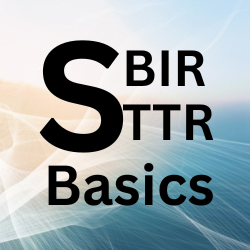A No-Nonsense Guide for SBIR/STTR Recipients
Congratulations if you’re an SBIR or STTR awardee! Now, you have funding to begin turning your big idea into something tangible. That money comes with strings. If you’re not careful (non-compliant), you could tank your patent rights faster than you can say “intellectual property.” Non-compliance with SBIR/STTR rules isn’t just a paperwork headache; it can cost you ownership of your invention. Let’s break it down and make sure you comply.
Why Patent Rights Matter
Your patent may be your golden ticket. It keeps competitors from ripping off your work and ensures you can cash in on your innovation. When the government funds your research under the SBIR (Small Business Innovation Research) or STTR (Small Business Technology Transfer) programs, it expects you to play by their rules to protect your IP. Mess up, and you might hand over your rights to Uncle Sam or lose them entirely. No pressure, right?
The Big Rules You Can’t Ignore
SBIR/STTR programs have specific requirements to secure your patent rights. These aren’t suggestions, they’re non-negotiable. Here’s what you need to know:
Disclose Your Invention Pronto
The feds want to know about your brainchild. If you develop an invention under an SBIR/STTR award, you have to disclose it to the funding agency two months after realizing it’s a patentable idea. Disclosure isn’t optional. You could lose your right to file a patent if you miss the deadline. Period.
- What to include: Describe the invention, who worked on it, and how it ties to the funded project.
- How to do it: Submit through the agency’s portal or as instructed in your award docs. Don’t just email it to some random government address.
Elect to Retain Title
Want to keep ownership of your invention? You have to tell the government you’re claiming it (called”electing title”). You’ve got two years from disclosure (or less if the project ends sooner). The government can claim your IP if you don’t formally elect to title. Yeah, it’s as bad as it sounds.
- Pro tip: Put this deadline on your calendar. Twice. And set a reminder.
File Your Patent Application
Once you’ve elected to title, you’ve got one year to file your patent application (or a provisional one). Miss this, and you’re flirting with disaster. The government can take your invention if you drag your feet. Also, you must include a specific statement in your patent application acknowledging federal funding. (The details are under types of patents and utility patent specifications.) The statement is non-negotiable. It proves the government’s involvement. Here’s the exact language you need:
“This invention was made with government support under [insert grant/contract number] awarded by [insert name of federal agency]. The government has certain rights in the invention.”
- Replace the bracketed parts with your specific grant or contract number and the agency (e.g., NIH, DOD, NASA).
- This statement typically goes in your patent application’s “Background” or “Government Rights” section. Your patent attorney will know where to stick it.
- If you forget this, the USPTO might reject your application, or the government could challenge your patent later. Please don’t skip it.
- Heads-up: If you publish or present your invention publicly before filing, you could lose patent rights in some countries. Talk to a patent attorney before you show off at a conference.
Report, Report, Report
SBIR/STTR isn’t a “set it and forget it” deal. You must keep the government in the loop on your patent progress, filing annual reports, updates on commercialization, and notifying them if you license or sell your IP. Skip these, and you risk penalties or losing your rights.
- Where to report: Check your award agreement. Most agencies use systems like iEdison for IP reporting.
- Don’t half-ass it: Incomplete or late reports can trigger audits or worse.
Play Nice with Collaborators
STTR folks, listen up: You’re working with a research partner (like a university). Make sure your agreements spell out who owns what IP. If you don’t, you could end up in a legal mess where your partner claims half your patent. SBIR awardees, you’re not off the hook. Subcontractors can complicate things, too. Get those contracts airtight.
Common Mistakes to Avoid
I’ve seen too many smart people fumble their patent rights. Don’t be one of them. Here’s what trips folks up:
- Thinking disclosure is optional: It’s not. Even if you’re not sure it’s patentable, disclose it anyway.
- Missing deadlines: Set reminders, hire a lawyer, do whatever it takes. Timing is everything.
- Forgetting the government rights statement: That specific language in your patent app is mandatory. No excuses.
- Sloppy record-keeping: Document every step, disclosures, elections, and filings. If the government audits you, you’ll need proof.
- Ignoring commercialization: SBIR/STTR wants you to profit from your invention. If you sit on it, they might question your commitment.
- DIY patenting: Patent law is a beast. Get a qualified attorney who knows SBIR/STTR rules.
The Government’s Cut
Here’s the deal: The feds don’t want your patent but want a piece of the action. If you get an SBIR/STTR award, the government receives a non-exclusive, royalty-free license to use your invention for its purposes. That’s non-negotiable, which is why your patent application’s government rights statement matters. But if you follow the rules, you keep the right to commercialize and profit from your work. Screw up, and they could take more than just a license. Another thing to note is that, should the government need your invention and you can’t produce it, they have the right to have it made by another company.
Get Your Act Together
So, protecting your patent rights under SBIR/STTR isn’t rocket science, but it takes discipline. Here’s your game plan:
- Know your deadlines: Disclosure, title election, patent filing, and mark them in blood.
- Hire a pro: A patent attorney who gets SBIR/STTR can save your bacon.
- Nail the government rights statement: Use the exact language, and double-check it.
- Stay organized: Use tools like iEdison and keep meticulous records.
- Talk to your agency: If you’re confused, ask your program officer. They’re not the enemy.
- Don’t procrastinate: Every delay is a chance to lose what’s yours.
Final Word
Your SBIR/STTR award is a shot at greatness, but it’s not a free ride. Patent rights are your lifeline to turning your idea into a business. Don’t let laziness or ignorance screw it up, especially not by forgetting that all-important government rights statement. Follow the rules, stay sharp, and keep what’s yours. Now build something extraordinary, and don’t say I didn’t warn you.
Disclaimer: I’m not a lawyer. I am a compliance and business expert with a knack for breaking things down. For legal advice, consult a patent attorney.

